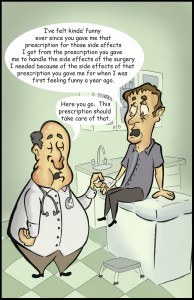Monsanto Company Profile part II of IV
Monsanto is a new company. No longer a chemical company, the new Monsanto is an agricultural company, a leader in biotech and GMO technology. Their pledge begins with these words:
We want to make the world a better place for future generations. As an agricultural company, Monsanto can do this best by providing value through the products and systems we offer to farmers.”
Sustainable Yield Initiative
Monsanto states its goal is to increase yields while maintaining or reducing inputs of energy and pesticides through the use of genetically modified crops. Monsanto’s Sustainable Yield Initiative puts forth a goal to double crop yields in corn, soy, and cotton by the year 2030, from the baseline year, 2000. “That’s in countries that have bio-technology, that have adapted that,” says Brad Mitchell, Director of Public Affairs. “And do that using 1/3 less inputs, so nitrogen, water, etcetera… And by doubling those yields we will improve farmer’s lives because more yield means more money in their pockets, and profitability increases.”
Mitchell brags that their biotech is “…skill neutral technology. A farmer in the middle of Iowa will use it and then you can also have a farmer in Argentina use it and it will yield pretty well. It’s something that both can use on their farm no matter how much–if he has 500 acres or 5 acres, they both benefit.”
Monsanto’s biotech seeds are patented. Farmers are not allowed to retain patented seeds from a crop. Each season they are required to purchase new seeds. For this, Monsanto has come under attack, with critics claiming this practice to be unnatural and unsustainable. Mitchell says, “… a lot of people make a big deal about Monsanto patentingseeds, and how this is going to lead to control over the seed supply and that sort of thing. I have two responses to that. One is, first, patenting of seeds is not new and it’s not unique to either Monsanto or biotech. And if you don’t believe me, go google raspberry and patents and see what you come up with. There are plenty of patent varieties of raspberries out there, and everything from asparagus to zucchini. Basically if people Genetic Modification didn’t have the ability to patent the result of their breeding, there would be no incentive for them to do so.”
Mitchell continues, “The other part of it that I find a little bit amusing and a little bit disheartening is that when people say, ‘Oh well, you can’t save patented seeds. This is the end of the world.’ Well, we’ve had hybrid seeds in production and available to farmers for just about 70 years. And with the vast majority of hybrid seeds, you can’t save those either. And nobody’s made a big deal about that. And the reason you can’t save hybrids, some of them are patented, but more importantly, the offspring seed doesn’t have the genetic consistency of the parent, so no farmer will ever save a hybrid seed because they are not going to know what they are getting. Farmers who have had hybrid seed available for over 70 years they choose them because namely because they give better yields. Some of them have some other traits that they appreciate.”
Due to patent protection and patent infringement investigations, Monsanto employs a number of investigators. Mr. Mitchell could not tell us the exact number, but he estimates the number to be around 40. “And those aren’t all full time, doing this for us, they’re private investigator firms, so a good part of the year they’re not doing save-seed stuff, they’re doing other whatever else investigators do. These are private firms.”
Lawsuits Against Farmers
In films that criticize Monsanto and their relationship with farmers, Monsanto is accused of using their investigators and lawsuits to harass and intimidate. Mitchell says that out of half a million customers, Monsanto has filed 138 lawsuits for patent infringement and nine went to trial; the others settled out of court.
“Now, we kind of have to do this for three reasons,” Mitchell says. “One is we’re not going to make any money if people aren’t buying our products. I mean there’s the patent infringement issue. Two is we owe it to our stockholders, because they invest in this. And a good part of it is, you know, frankly, we put ten percent of our money into research and development, so the third part of this is really if people are getting this technology without paying for it, we’re not going to be able to do that. And we’re not going to see the state of technology today…probably a lot of your readership would like that but not necessarily a lot of the farmers out there.”
“So we’ve got about half a dozen people who have claimed that we have committed these misdeeds. I don’t see it. I was actually outat a farm the other day and we had a seed patent investigation in the neighborhood, and he goes, ‘You know, my neighbor is really upset with you guys. He’s furious with how you handledthis seed patent infringement case.’ (Against the farmer we had a case against and we settled.)’ And I said,’Uh-oh. What’s his problem? And he said, ‘He doesn’t think you went after enough.’ So what we typically hear from farmers is, “Look, I gotta pay for it. Yeah, I’d rather not pay for it and I’d rather not pay for gasoline or my taxes either, but if I’m going to do it, the other guy better, too, because it’s not fair.” Farmers who have
settled cases with Monsanto have said they cannot discuss the terms of the settlements, that Monsanto insisted on non-disclosure clauses. Mitchell insists the opposite is true, that the farmers were the ones who asked for the non-disclosures. “Unfortunately what’s happened is that people have turned that against us and said, ‘Well, Monsanto requested these.’ We don’t request nondisclosure and we never have. We, in the past, have agreed to it, but we don’t do it anymore for that very reason.” The money from all of the settlements has been donated to agricultural charities and scholarships. “The ones that actually went through full trial [9 cases], we do retain that, mainly because trials are expensive.”
Human Rights
Hugh Grant, Monsanto Chairman, President and Chief Executive Officer, is quoted on Monsanto’s website. He states, “As an agricultural and technology company committed to human rights, we have a unique opportunity to protect and advance human rights. We have a responsibility to consider not only how our business can benefit consumers, farmers, and food processors, but how it can protect the human rights of both Monsanto’s employees and our business partners’ employees.”
Monsanto identifies nine elements in its human rights policy: child labor, forced labor, compensation, working hours, harassment and violence, discrimination, safety, freedom of association, and legal compliance.
Forced, indentured, or bonded labor is unacceptable to Monsanto and Monsanto rejects corporal punishment of any type. Compensation is to meet or exceed minimum wage standards, regardless of performance measures. Monsanto states they will comply with all laws and industry standards with regard to working hours. Harassment, violence, and discrimination will never be tolerated. Monsanto is committed to safety, to the rights of workers to join or not join organizations of their choosing, to associate
freely and bargain collectively. And last but not least, Monsanto states that it “will comply with all applicable local, state and national laws regarding human rights and workers’ rights where the company does business.”
While Monsanto supports young people working within the agricultural business, it wants to ensure that all applicable local, state, and national laws are followed and that none of its business partners practice exploitive child labor practices. To this end, in India Monsanto has added “no child labor” clauses into farmer and third party contracts, has instigated a massive farmer awareness campaign with posters, door to door visits, leaflets, postcards, field audits 10-12 times during the 45-60 pay pollination period (auditors conducted more than 10,000 field visits in 2007), and written farm attendance reports.
Monsanto has also employed incentive/disincentive schemes, paying farmers an incentive if they employ only adult labor. If a farmer is found to be in violation, the child(ren) are removed from the field, the farmer becomes ineligible for incentives, and Monsanto discontinues production with the farmer the following year. The Monsanto Fund, established in 1964, gives funds to communities in the United States and around the world in the company’s areas of operations, including a residential learning center for child laborers, in a further effort to stop the practice of using child labor.
In 2007, The Monsanto Fund pledged 12.6 million to numerous causes around the world.
In our final report on Monsanto, we will discuss seed monopolies, Indian farmer suicides, conflicting reports on crop yields, Roundup safety, and bans on GM crops.
Recommended Reading:
- Understanding and Detoxifying Genetically Modified Foods
- Monsanto part I
- Monsanto part III
- Monsanto part IV

 The author of the email attacking my article comes up with nothing new- no new ideas, no fresh insight, no worthwhile assertions. His comments are a very average-level parroting of standard media propaganda which has formed the public perception of vaccines for the past 200 years. The same phrases, the same mantras, the same disregard for scientific fact, physiological processes and actual historical events. So Average Parrot here has put no special effort into researching the areas on which he is holding forth; merely repeating back the same timeworn phrases he has passively absorbed during a lifetime of standard conditioning through popular media. It’s all rhetoric, all chatter, notable for its complete lack of supporting references. This is one of the hallmarks of mundane propaganda – no documentation.
The author of the email attacking my article comes up with nothing new- no new ideas, no fresh insight, no worthwhile assertions. His comments are a very average-level parroting of standard media propaganda which has formed the public perception of vaccines for the past 200 years. The same phrases, the same mantras, the same disregard for scientific fact, physiological processes and actual historical events. So Average Parrot here has put no special effort into researching the areas on which he is holding forth; merely repeating back the same timeworn phrases he has passively absorbed during a lifetime of standard conditioning through popular media. It’s all rhetoric, all chatter, notable for its complete lack of supporting references. This is one of the hallmarks of mundane propaganda – no documentation.